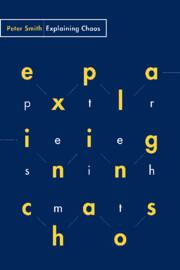6 - Universality
Published online by Cambridge University Press: 22 September 2009
Summary
An applied chaotic dynamical theory claims, in essence, ‘the time-evolution of the relevant real-world quantities has this intricate structure’. As we have seen, despite its non-empirical surplus content, such a theory can count as approximately true; and, despite sensitive dependence on initial conditions, it can be richly predictive. It will not be straightforwardly causal-explanatory (§5.1): but that does not stop the theory being explanatory in other ways. And our next major task is to say something about the sorts of explanations that chaotic dynamics can deliver.
As background, we need to take on board rather more of the elementary mathematics of chaos. That's the business for this largely expository chapter. Careful exposition will, in particular, remove the appearance of number-magic that can attach to chaotic dynamics (§6 below). As usual, the headline news is in the main text; the purely mathematical interludes here fill in a few details and sketch some proofs, but can be skipped.
We begin by turning our attention away from the Lorenz system to another standard exemplar of chaos, the so-called ‘logistic map’, which is a discrete map defined over the unit interval. At first sight, this might look like a radical change of tack. So far, we have been discussing the behaviour of phase space trajectories that are solutions to sets of linked first-order differential equations in the standard form (D).
- Type
- Chapter
- Information
- Explaining Chaos , pp. 91 - 112Publisher: Cambridge University PressPrint publication year: 1998



